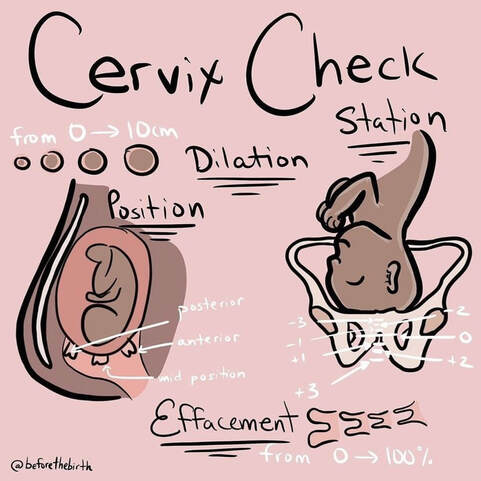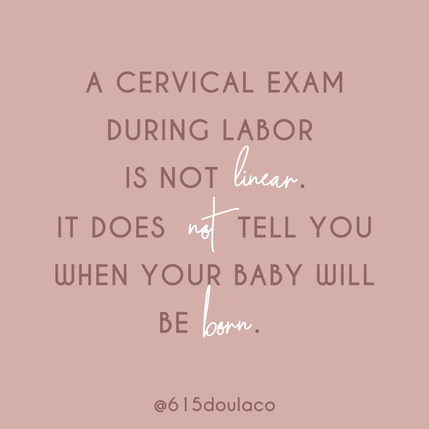|
What do you know about your cervix? We find that many of us aren’t well informed about our cervixes, but it is such a dynamic and interesting part of our body and does so much during our fertility, pregnancy, and birth journeys. So, we have compiled a blog post to give you the 411 on your cervix! This comes after our Instagram series on the cervix in honor of January’s Cervical Health Month. Let's start with the basics...What is a cervix?The cervix is a canal that connects your uterus to your vagina. It comes from the Latin word ‘neck’ and is sometimes called the "neck of the uterus". In the below image, you can see that the cervix in a non-pregnant woman, tilts more towards the back. Some Interesting Facts about the Cervix:
Now that we have labeled, and chatted about the non-pregnant cervix, let’s move into talking about the cervix during pregnancy. We will discuss: what a cervical exam is and what it is not, what cervical checks measure, pros and cons of cervical checks, and how to advocate regarding cervical checks during pregnancy and labor. What is a Cervical Exam (or cervical check)?Cervical exams check the cervix for common changes that occur throughout pregnancy and labor! You may think that measuring a cervix is a precise business that includes a special tool. It's not! It is literally someone spacing out their fingers to determine how many centimeters open the cervix is. As you can imagine, this is highly subjective. Many labor care teams work to norm their measurements, but we commonly see one provider like an OB saying one dilation and then a nurse or another care provider saying another. It can really throw you for a loop, but as long as you know, you can temper your expectations of its precision. What Does a Cervical Check Measure?Well first, they measure more than just dilation! They actually measure 5 different metrics:
Pros and Cons of Cervical Checks During LaborAs with many things during birth, there are pros and cons. We believe it is very important to be informed and to know both the positives and negatives of birth options. This stands true for cervical checks as well. Below are *some* of the positives and negatives of cervical checks during labor. Once you know some of these positives and negatives, you can make an informed decision about them for your birth plan and then advocate for your preferences during labor. Pros: - gives data that can be helpful, such as whether to be admitted to your birth place. As a doula trained in spinning babies, it gives me some additional data points to recommend specific positions or movements to ensure baby is in the best position for a smooth birth. - can encourage you if you like the way you are progressing - can give you the go-ahead to push with the urge after 10 cm (we don't want to push before 10 - the cervix can swell) Cons: - introduces bacteria and therefore increases risk of infection - it can hurt and feel foreign - can disrupt your labor flow, including getting in an uncomfortable position - can discourage you if you haven't yet made the progress you were hoping for - some may pressure you to begin pushing as soon as you reach 10cm, instead of honoring "laboring down" and spontaneous pushing (see previous posts re: pushing) A Note About Cervical Exams During PregnancyIncreasingly, routine cervical exams during pregnancy (without specific evidence of need) are going to the wayside, and for good reason. Sometimes you still hear that OB's are requiring cervical exams during pregnancy, sometimes early on, and for all of their patients. We also hear of OB's beginning/restarting cervical exams weekly at 36 weeks. Some offer it and others expect it. We find that there is a fairly reliable overlap with the doctors that do routine cervical checks during pregnancy and those that favor old-school hospital style birthing where they know better and intervene often (inductions, pushing on your back, limiting food and drink, etc.). We find that many of the most consent and evidence-based providers that honor the safest low-intervention path, don't usually have routine cervical exams as part of their pregnancy care protocol. It might not be the full picture of a provider, but it is a clue. As always, there are exceptions. For example: if you have a history or there are signs for preterm labor, a cervical exam could be helpful in mapping out your care plan. You, do you. You Get to Choose
Here are our best tips:
0 Comments
Leave a Reply. |
Meet Nicki
Hi, I'm Nicki! I am a Nashville based Doula and founder of 615 Doula Co! My favorite part of working as a Doula is supporting families through the life transitions of pregnancy, birth, and postpartum life. Explore Blog |







